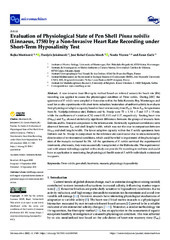| dc.creator | Martinović, Rajko | |
| dc.creator | Joksimović, Danijela | |
| dc.creator | García-March, José Rafael | |
| dc.creator | Vicente, Nardo | |
| dc.creator | Gačić, Zoran | |
| dc.date.accessioned | 2022-10-06T08:59:49Z | |
| dc.date.available | 2022-10-06T08:59:49Z | |
| dc.date.issued | 2022 | |
| dc.identifier.issn | 2072666X | |
| dc.identifier.uri | http://rimsi.imsi.bg.ac.rs/handle/123456789/1573 | |
| dc.description.abstract | A non-invasive laser fiber-optic method based on infrared sensors for heart rate (Hr) recording was applied to assess the physiological condition of Pinna nobilis. During 2017, the specimens of P. nobilis were sampled at three sites within the Boka Kotorska Bay, Montenegro and used for ex situ experiments with short-term reduction/restoration of ambient salinity to evaluate their physiological adaptive capacity based on heart rate recovery time (Trec). Mean Trec for specimens from Sv. Nedjelja (reference site), Dobrota and Sv. Stasije were 72 ± 3, 91 ± 7 and 117 ± 15 min, while the coefficients of variation (CV) were 0.12, 0.13 and 0.17, respectively. Resting heart rate (Hrrest) and Trec showed statistically significant differences between the groups of mussels from Dobrota and Sv. Stasije in comparison to the reference site. Statistically significant correlations were observed between Trec and shell length/width, which was not the case in comparison between Hrrest and shell length/width. The lower adaptive capacity within the P. nobilis specimens from Dobrota and Sv. Stasije in comparison to the reference site could occur due to stress induced by deterioration of environmental conditions, which could have led to impairment of the physiological state of the mussels evaluated by Hr. All the specimens of P. nobilis survived the experimental treatments; afterwards, they were successfully transplanted at the Dobrota site. The experimental unit with sensor technology applied in this study can provide Hr recording in real time and could have an application in monitoring the physiological/health state of P. nobilis individuals maintained in aquaria. | sr |
| dc.language.iso | en | sr |
| dc.publisher | MDPI | sr |
| dc.rights | openAccess | sr |
| dc.rights.uri | https://creativecommons.org/licenses/by/4.0/ | |
| dc.source | Micromachines | sr |
| dc.subject | heart rate | sr |
| dc.subject | hyposalinity | sr |
| dc.subject | mussels | sr |
| dc.subject | pen shell | sr |
| dc.subject | physiology | sr |
| dc.subject | Pinna nobilis | sr |
| dc.title | Evaluation of Physiological State of Pen Shell Pinna nobilis (Linnaeus, 1758) by a Non-Invasive Heart Rate Recording under Short-Term Hyposalinity Test | sr |
| dc.type | article | sr |
| dc.rights.license | BY | sr |
| dc.citation.issue | 9 | |
| dc.citation.spage | 1549 | |
| dc.citation.volume | 13 | |
| dc.identifier.doi | 10.3390/mi13091549 | |
| dc.identifier.fulltext | http://rimsi.imsi.bg.ac.rs/bitstream/id/3820/Evaluation-of-Physiological-State-of-Pen-Shell-Pinna-nobilis-Linnaeus-1758-by-a-NonInvasive-Heart-Rate-Recording-under-ShortTerm-Hyposalinity-TestMicromachines.pdf | |
| dc.type.version | publishedVersion | sr |

